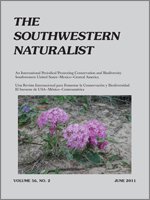During two studies of mortality in fawns of desert mule deer (Odocoileus hemionus eremicus) in Crockett County, Texas, and Gila County, Arizona, we recorded rates of retention and problems with vaginal-implant transmitters (VITs). Our objectives were to determine if rates of retention differed between studies, years, timing of insertions, and width of wing of VITs. In Texas, VITs with wings 6.75-cm wide were shed successfully at parturition 73–77% of the time, whereas in Arizona, VITs were shed successfully 43% of the time. Additionally, in Arizona, VITs with 8.20-cm-wide wings were shed successfully 91% of the time. Our data suggested that optimal length of wings of VITs for mule deer may be dependent on locale. When designing a study using VITs, researchers should use the largest wing possible to ensure high rates of retention without physically harming deer.
How to translate text using browser tools
1 June 2011
Evaluation of Use of Vaginal-Implant Transmitters in Mule Deer (Odocoileus hemionus)
Nicole M. Tatman,
Warren B. Ballard,
Mark C. Wallace,
Shawn P. Haskell,
Paul R. Krausman,
James Devos Jr.,
Ole J. Alcumbrac
ACCESS THE FULL ARTICLE

The Southwestern Naturalist
Vol. 56 • No. 2
June 2011
Vol. 56 • No. 2
June 2011




